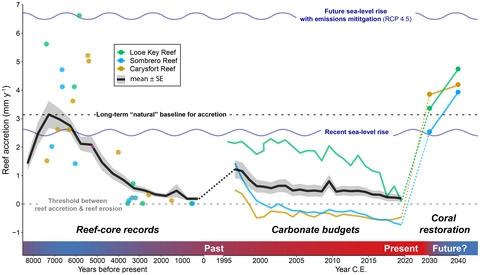当前位置:
X-MOL 学术
›
Glob. Change Biol.
›
论文详情
Our official English website, www.x-mol.net, welcomes your feedback! (Note: you will need to create a separate account there.)
The past, present, and future of coral reef growth in the Florida Keys
Global Change Biology ( IF 11.6 ) Pub Date : 2022-07-05 , DOI: 10.1111/gcb.16295 Lauren T Toth 1 , Travis A Courtney 2, 3 , Michael A Colella 4 , Selena A Kupfner Johnson 1 , Robert R Ruzicka 4
Global Change Biology ( IF 11.6 ) Pub Date : 2022-07-05 , DOI: 10.1111/gcb.16295 Lauren T Toth 1 , Travis A Courtney 2, 3 , Michael A Colella 4 , Selena A Kupfner Johnson 1 , Robert R Ruzicka 4
Affiliation

|
Coral-reef degradation is driving global-scale reductions in reef-building capacity and the ecological, geological, and socioeconomic functions it supports. The persistence of those essential functions will depend on whether coral-reef management is able to rebalance the competing processes of reef accretion and erosion. Here, we reconstructed census-based carbonate budgets of 46 reefs throughout the Florida Keys from 1996 to 2019. We evaluated the environmental and ecological drivers of changing budget states and compared historical trends in reef-accretion potential to millennial-scale baselines of accretion from reef cores and future projections with coral restoration. We found that historically, most reefs had positive carbonate budgets, and many had reef-accretion potential comparable to the ~3 mm year−1 average accretion rate during the peak of regional reef building ~7000 years ago; however, declines in reef-building Acropora palmata and Orbicella spp. corals following a series of thermal stress events and coral disease outbreaks resulted in a shift from positive to negative budgets for most reefs in the region. By 2019, only ~15% of reefs had positive net carbonate production. Most of those reefs were in inshore, Lower Keys patch-reef habitats with low water clarity, supporting the hypothesis that environments with naturally low irradiance may provide a refugia from thermal stress. We caution that our estimated carbonate budgets are likely overly optimistic; comparison of reef-accretion potential to measured accretion from reef cores suggests that, by not accounting for the role of nonbiological physical and chemical erosion, census-based carbonate budgets may underestimate total erosion by ~1 mm year−1 (−1.15 kg CaCO3 m−2 year−1). Although the present state of Florida's reefs is dire, we demonstrate that the restoration of reef-building corals has the potential to help mitigate declines in reef accretion in some locations, which could allow some key ecosystem functions to be maintained until the threat of global climate change is addressed.
中文翻译:

佛罗里达群岛珊瑚礁生长的过去、现在和未来
珊瑚礁退化正在推动全球范围内珊瑚礁建设能力及其支持的生态、地质和社会经济功能的减少。这些基本功能的持久性将取决于珊瑚礁管理是否能够重新平衡珊瑚礁增生和侵蚀的竞争过程。在这里,我们重建了 1996 年至 2019 年整个佛罗里达群岛 46 个珊瑚礁的基于人口普查的碳酸盐预算。我们评估了不断变化的预算状态的环境和生态驱动因素,并将珊瑚礁增殖潜力的历史趋势与千年尺度的珊瑚礁增殖基线进行了比较珊瑚恢复的核心和未来预测。我们发现,从历史上看,大多数珊瑚礁具有正的碳酸盐预算,并且许多珊瑚礁的增长潜力与约 3 毫米年-1相当约 7000 年前区域造礁高峰期的平均增生率;然而,造礁的Acropora palmata和Orbicella的数量下降spp. 一系列热应激事件和珊瑚病爆发后的珊瑚导致该地区大多数珊瑚礁的预算从正预算转变为负预算。到 2019 年,只有约 15% 的珊瑚礁具有正的净碳酸盐产量。这些珊瑚礁中的大多数位于近岸、下基斯岛斑块珊瑚礁栖息地,水的透明度较低,这支持了这样一种假设,即天然低辐照度的环境可能会为热应激提供避难所。我们警告说,我们估计的碳酸盐预算可能过于乐观;将礁体吸积潜力与测量的礁核吸积进行比较表明,由于不考虑非生物物理和化学侵蚀的作用,基于人口普查的碳酸盐预算可能会低估总侵蚀约 1 毫米年-1(-1.15 千克 CaCO 3米-2年-1 )。尽管佛罗里达州珊瑚礁的现状很糟糕,但我们证明了重建珊瑚礁的珊瑚有可能有助于缓解某些地方珊瑚礁增生的减少,这可以使一些关键的生态系统功能得以维持,直到全球气候受到威胁变化得到解决。
更新日期:2022-07-05
中文翻译:

佛罗里达群岛珊瑚礁生长的过去、现在和未来
珊瑚礁退化正在推动全球范围内珊瑚礁建设能力及其支持的生态、地质和社会经济功能的减少。这些基本功能的持久性将取决于珊瑚礁管理是否能够重新平衡珊瑚礁增生和侵蚀的竞争过程。在这里,我们重建了 1996 年至 2019 年整个佛罗里达群岛 46 个珊瑚礁的基于人口普查的碳酸盐预算。我们评估了不断变化的预算状态的环境和生态驱动因素,并将珊瑚礁增殖潜力的历史趋势与千年尺度的珊瑚礁增殖基线进行了比较珊瑚恢复的核心和未来预测。我们发现,从历史上看,大多数珊瑚礁具有正的碳酸盐预算,并且许多珊瑚礁的增长潜力与约 3 毫米年-1相当约 7000 年前区域造礁高峰期的平均增生率;然而,造礁的Acropora palmata和Orbicella的数量下降spp. 一系列热应激事件和珊瑚病爆发后的珊瑚导致该地区大多数珊瑚礁的预算从正预算转变为负预算。到 2019 年,只有约 15% 的珊瑚礁具有正的净碳酸盐产量。这些珊瑚礁中的大多数位于近岸、下基斯岛斑块珊瑚礁栖息地,水的透明度较低,这支持了这样一种假设,即天然低辐照度的环境可能会为热应激提供避难所。我们警告说,我们估计的碳酸盐预算可能过于乐观;将礁体吸积潜力与测量的礁核吸积进行比较表明,由于不考虑非生物物理和化学侵蚀的作用,基于人口普查的碳酸盐预算可能会低估总侵蚀约 1 毫米年-1(-1.15 千克 CaCO 3米-2年-1 )。尽管佛罗里达州珊瑚礁的现状很糟糕,但我们证明了重建珊瑚礁的珊瑚有可能有助于缓解某些地方珊瑚礁增生的减少,这可以使一些关键的生态系统功能得以维持,直到全球气候受到威胁变化得到解决。


























 京公网安备 11010802027423号
京公网安备 11010802027423号